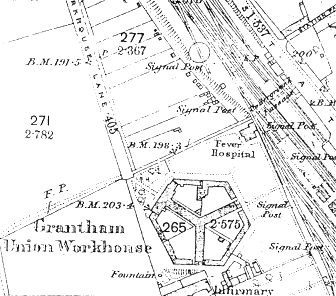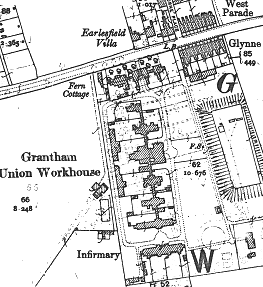Grantham, Lincolnshire
Up to 1834
A parliamentary report of 1777 recorded parish workhouses in operation at Grantham for up to 60 inmates, and at Great Ponton for up to 10 inmates.
An early Grantham workhouse is believed to have stood in Triggs Yard in Watergate.
After 1834
Grantham Poor Law Union was officially formed on 14th January 1836. Its operation was overseen by an elected Board of Guardians, 62 in number, representing its 52 constituent parishes as listed below (figures in brackets indicate numbers of Guardians if more than one):
County of Lincoln:
Ancaster, Barrowby, Basingthorpe, Belton, Bitchfield, Braceby, Boothby Pagnell, Burton Coggles, Carlton Scroope, Colsterworth, Denton, Easton, Grantham (7), Great Gonerby, Gunby, haceby, Harrowby, Harlaxton, Haydon, Honington, Hough-on-the-Hill, Humby, Ingoldsby, Kiesby, Lavington-on-Lenton, Londonthorpe, Manthorpe cum Little Gonerby (3), Normanton, Osgodby, Pickworth, Great Ponton, Little Ponton, Rospley, Sapperton, Skillington, Somerby, North Stoke, South Stoke, Stainby, Stroxton, Spittlegate (2), North Witham, South Witham, Welby, Woolsthorpe, Wyville-cum-Hungerton.
County of Leicester:
Bottersford (2), Croxton Kerrial, Harston, Knipton, Muston, Redmile.
The population falling within the Union at the 1831 census had been 22,839 with parishes ranging in size from Harrowby (population 54) to Grantham itself (4,590). The average annual poor-rate expenditure for the period 1833-35 had been £10,061 or 8s.10d. per head.
The 1837 Workhouse
The first Grantham Union workhouse was built in 1837 to the south-west of the town, to the west of the railway station. It was designed to accommodate up to 300 people and the Poor Law Commissioners authorized an expenditure of £6,000 for its construction. The architect was Sampson Kempthorne and the workhouse was based on his model hexagonal or "Y-plan" design. It comprised an entrance and administration block at the north-west, behind which three accommodation blocks radiated from a central supervisory hub. There was a fever block at the north of the site and separate infirmary was erected to the south.
The workhouse location and layout can be seen on the 1885 map below.

Grantham workhouse site, 1885.
In February, 1867, the workhouse and its medical facilities were the subject of an inspection by the Poor Law Board. Extracts from there report are given below.
The ordinary sick wards are in the body of the workhouse, and consist of one for women, one for girls, and one for men, besides the lying-in ward.
The general plan is that of the body of the workhouse in general, vie., narrow rooms, with beds on either hand, and a gangway down the centre.
The lying-in ward is also used by imbecile women and by children: but there are two small rooms, or, properly speaking, wooden boxes, in which the women are delivered, and in which they remain for a certain period afterwards.
There is a separate two-storied building for infectious cases in the garden, with itch ward, kitchen, and two other wards on the ground floor, and four sleeping rooms on the first floor, but as there are no means of separating the sexes, it is now exclusively devoted to men. At the present time there are no infectious cases in it, and the inmates are such as require separation from the general sick. The floors are of brick or plaster.
There are also three low one-storied buildings used for itch, syphilis, and offensive cases among women; but some of the latter class are retained in the ordinary wards. The general arrangements are not satisfactory, and it would be much better to build new sick wards in which all the sick cases could be placed together, and proper infectious and separation wards should be provided for both sexes. There are water-closets in the several rooms, or on the several floors. except in the one-storied rooms, but the window allows the air to enter the rooms. There are also sinks, which, with bowls, are used as lavatories but bowls and towels are taken into till the sick wards.
The bedsteads are of iron, and without racks, with beds of straw placed upon cocoa-fibre matting. The counterpanes are of cotton, and are old-looking. There are arm-chairs, tables, a few cupboards, nightstools, bowls, books, a few illustrated periodicals, and clock, but there are not any prints. Mackintosh sheeting and air-beds have just been obtained. There are not any air-cushions. Two portable baths have recently been obtained, but there are none for the sick.
The ventilation is effected by openings, with shutters or large sheets of perforated zinc, placed over the doors in the gangways, and by ventilators in the ceiling, covered with perforated zinc, and communicating with the outer air by air-bricks. In the separated buildings there is a small ventilator, with a shutter over each door.
In general the ventilation is defective, and in the men's ward the defect is further increased by the use of a stove which emits sulphureous odours. In no ward was the air fresh, and the boxes in the lying-in ward are really without ventilation.
There is one paid nurse, who has charge of all the patients in the four separate sets of wards, amounting to between 30 and 40; and although the medical officer is regarded as the accoucheur, the nurse really attends the lying-in cases. It is clear that she cannot well discharge all her duties, but she generally gives each dose of stimulants, whilst the pauper nurses give the doses of medicines.
There is not a paid night nurse. Should all the sick wards be consolidated, and proper infectious and separation wards he established, she would discharge her duties more easily; but it is probable that an assistant should be appointed.
The accommodation for men has lately proved inadequate, so much so that, it has been found necessary to take lodgings for some aged men in the town of Grantham. I found the men's ward much overcrowded to-day, while the women's wards are in some instances unoccupied. There are 64 aged and infirm men in the house, and only 26 aged and infirm women. Some old men sleep in wards under the wall of their yard, which must have originally been intended for workshops; these rooms are damp, and have brick floors. Two of the bedrooms intended for boys are occupied by old men. The lavatories and privies of the boys and girls are very imperfect. The lying-in wards (here called boxes) are wholly unfit for the purpose; they are small closets, with a window. The itch and syphilitic wards for women are unfit to be slept in; they are mere sheds, under the boundary wall of the women's yard; they are damp, and have brick floors.
There are detached wards male and fever and infectious cases; these wards are used its ordinary sick wards; they are close to, and are partially imbedded in, the bank of the railway station, so that all day and night the incessant noise of the trains is most trying to the sick. There is one paid nurse, but there should be two at the least. There is a want of easy chairs, of mackintosh sheets, of bed rests, and dressing gowns. There are no hot-water taps in the sick wards, nor bathrooms. The Guardians find cod-liver oil and quinine. There is a want of amusing books for the sick and aged. Many of the bedrooms are badly ventilated.
The Dysart Road Workhouse
In March 1890, the Grantham Board of Guardians decided that a new workhouse was needed. A competition was announced the following month for plans for a building to accommodate 200 inmates at 10½ acre site on the south side of Dysart Road to the west of the town. The successful design was submitted by Valentine Green and the new building was erected in 1891-2 at a cost of £27,000. The old workhouse site was sold to the Great Northern Railway for the sum of £13,500.
The Dysart Road workhouse adopted the then popular pavilion plan. A central administrative block was linked by a covered corridor to a number of separate two-storey blocks at each side for the various classes of inmate. There was a separate two-storey infirmary at the south of the site. A 60-foot high stone-clad water tower became a landmark in the area. Tramp wards stood along the Dysart Road frontage. The Dysart Road site is shown on the 1903 map below:

Grantham new workhouse site, 1903.
The workhouse later became Hill View Hospital. Most of the buildings were demolished in the late 1960s. The water tower survived until 1975.
Staff
Inmates
Records
Note: many repositories impose a closure period of up to 100 years for records identifying individuals. Before travelling a long distance, always check that the records you want to consult will be available.
- Lincolnshire Archives, St. Rumbold Street, Lincoln LN2 5AB. Limited holdings include: Guardians' minute books (1863-1930); Service register (1862-1930); etc.
Bibliography
- Bygone Grantham by Michael Pointer and Malcolm Knapp.
Links
- None.
Unless otherwise indicated, this page () is copyright Peter Higginbotham. Contents may not be reproduced without permission.


